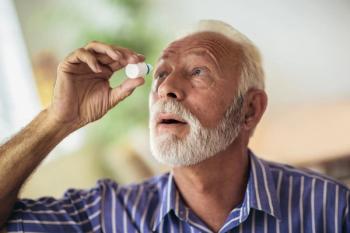
Researchers give dry eye a closer look
Classify and treat patients with dry eye disease (DED) according to the severity of their presenting signs and symptoms, more so than by causative factors, said Karen Dunlap, OD, here at the 5th annual Evidence Based Care in Optometry conference.
Key Points
Baltimore-Classify and treat patients with dry eye disease (DED) according to the severity of their presenting signs and symptoms, more so than by causative factors, said Karen Dunlap, OD, here at the 5th annual Evidence Based Care in Optometry conference.
The diagnosis, management, and treatment of DED have continued to overwhelm clinicians. Yet, with the aid of some expert data reviews, the puzzle of this condition has been pieced together and successful management is now a possibility, said Dr. Dunlap, assistant professor, Wilmer Eye Institute, Baltimore.
Setting the standards
"Why not have the professionals sort through all of the literature and come up with some sort of a consensus? This is what the Delphi Panel did," she said.
Define and conquer
One of the first things the members of the Delphi Panel did was propose that DED really should not be called "dry eye," but rather "dysfunctional tear syndrome" (DTS).
"In actuality, ocular surface disease can be caused by imbalances in the composition of the tears and not necessarily by a lack of tear production," she said.
Treatment recommendations from the panel have been published as the "Dry eye severity-grading scheme."1 The panel came to the consensus that treatment should actually be based more on the severity of the dry eye rather than on what etiologic factors caused it.
Cause and effect
"That's not to say that we should not identify the causative factors. We certainly want to see if it is more evaporative or more aqueous deficient," she noted. "But when it comes to treatment, it can become confusing, because a lot of these factors will overlap. Whether it's environment or allergy, lid disease, or lacrimal gland problems, they can all cause tear hyperosmolarity, inflammation, and lead to epithelial cell damage."
When deciding on treatment for dry eye, look more to the severity of the signs and symptoms, Dr. Dunlap advised. Mild dry eye treatment should consist of environmental modifications, tears, gels, and improved hygiene.
More moderate cases of dry eye will require plugs, steroids, or cyclosporine ophthalmic (Restasis, Allergan), and vitamin supplements such as omega-3 and flax seed oil. For more severe dry eye, more severe therapies will be required, and may include systemic medications, tarsorrhaphy, and cauterization, she explained.
Corticosteroids also have a role in the treatment of both evaporative and aqueous-deficient dry eye because inflammation can be involved in almost every type of dry eye disease.
"Steroids may make a lot of ODs nervous, but we would be doing a disservice to our patients if we didn't take advantage of steroids when they were indicated," Dr. Dunlap said.
"Many doctors think that steroids are only for aqueous-deficient dry eye; however, evaporative dry eye can also lead to tear hyperosmolarity, which ultimately triggers inflammatory mediators."
Clinically, however, it is often difficult to measure inflammation, she noted. Measuring hyperosmolarity can be helpful in those cases in which inflammation is not obvious upon slit lamp exam. A new osmolarity testing system (TearLab Osmolarity Test, TearLab Corp.) only recently became available, and it can be used to determine the osmolarity of tears. In addition, conjunctival impression cytology is also available, and this involves looking at ocular surface cells under a light microscope to determine the size and health of the goblet cells as well as the epithelial cells.
"There is a need for better tests and tools," she said. "There will be times when we will just have to assume that inflammation is involved. Severe clinical findings in asymptomatic patients can indicate chronicity and loss of corneal sensation."
Newsletter
Want more insights like this? Subscribe to Optometry Times and get clinical pearls and practice tips delivered straight to your inbox.
















































.png)


